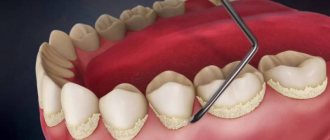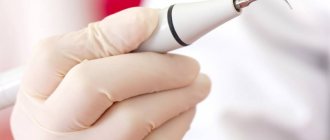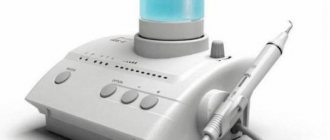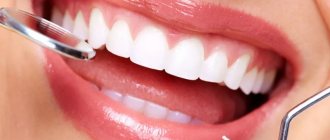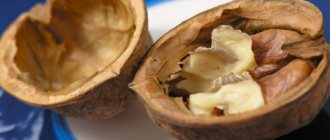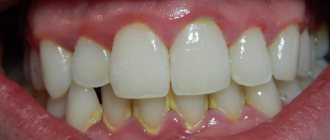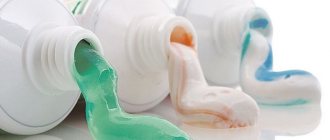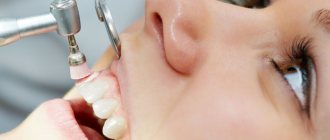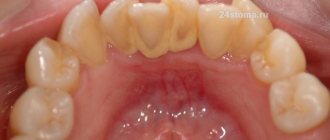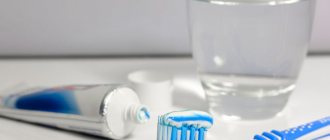Why do deposits appear on teeth?
The appearance of stone on initially light-colored teeth is due to various pathogenic and conditionally pathogenic microflora. The process is promoted by streptococci, lactobacilli, some types of Treponema and many other bacteria, the treatment of which is impossible due to their widespread distribution. Plaque is nothing more than the products of their active life in the oral cavity.
Daily brushing of teeth is not able to completely remove this deposit, even if done after every meal. After all, not all hard-to-reach places can be reached with a regular brush or thread. Interdental spaces, crevices and grooves in the back teeth, as well as the area of the neck of the tooth are difficult to clean on your own.
Laser technologies in professional oral hygiene
Laser teeth cleaning is an innovative technique in dentistry that allows you to non-contactly clean the tooth surface from massive dental plaque and tartar. The effectiveness of this procedure is one hundred percent. The patient does not experience any discomfort. Tooth enamel that has darkened or yellowed over time due to various environmental factors (food, drinks, tobacco smoke) becomes significantly whiter. In addition, laser treatment of the oral cavity destroys all pathogenic microflora and leaves no chance for the appearance of carious processes. Laser removal of dental stones is the safest and most effective method that does not damage the hard tissues of the tooth and completely eliminates the problem. The entire procedure takes, on average, 20 minutes. But there are also certain contraindications:
- visitors under 18 years of age;
- pregnancy;
- problems with the cardiovascular system;
- bronchitis and asthma in the period of exacerbation;
Types of Tartar
Before you treat dental deposits, you need to understand what they are. The deposit can be soft or hard, with the former transitioning into the latter. Naturally, it is easier to treat the first option. Also, depending on the location, supragingival and subgingival deposits are distinguished. The first ones are easily identified, since they are not hidden by the gum. Identifying the latter is difficult, since they are covered by the gums.
When soft plaque accumulates and has not been removed for a long time, it hardens and thickens, resulting in the appearance of deposits on the teeth. These deposits can only be removed in a dental office using a special technique.
Is it harmful - ultrasonic removal of dental plaque?
Many patients are interested in the question of the safety of ultrasonic removal of dental plaque. We hasten to reassure you - the safety of the procedure has long been proven and confirmed by a number of clinical studies. The use of ultrasonic equipment to remove plaque and tartar from teeth does not cause any negative side reactions or pathological changes in the human body.
However, it is worth considering that there are a number of contraindications to the procedure that must be taken into account. Ultrasound removal of dental plaque should be avoided if you have serious pathologies of the heart and blood vessels, severe respiratory diseases, pathological tooth sensitivity, and ultrasonic teeth cleaning is not performed in children and adolescents.
During pregnancy, it is possible to remove dental plaque with ultrasound, but not in the first trimester.
Calculate the cost of treatment by taking a short test in 20 seconds!
Do not delay your treatment, because in this matter time plays against us.
Existing contraindications
Contraindications to the treatment of deposits are not as extensive as one might think. Treatment is not carried out only in cases where the patient is in an exacerbation of any chronic disease or advanced oncology has been identified. Also, treatment is not carried out in the acute phase of the inflammatory process, during the period of active colds.
Consultation and diagnostics
Making a treatment plan
Treatment procedure
Preventive examination
Cost of services
Laser cleaning requires high professionalism of doctors. For this reason, you need to approach the choice of dentistry with special attention.
Clinic A-Medic is a laser dentistry center that provides laser teeth cleaning services at the best prices in Moscow. We are confident in the quality of the work of our specialists, so we provide a guarantee of results. On the clinic’s website you can always read reviews from our patients, as well as see “before and after” photos of cleaning.
The cost of services is indicated in the fixed price list. All information about prices, specialists and the procedure itself can be found on the dentist’s website or from the center’s consultants by phone. Pre-registration is available on the clinic website. Leave a request and our specialists will contact you to schedule a consultation with a doctor at a time convenient for you.
Choosing a method
Deposits on teeth can only be removed in a dental clinic using modern techniques, such as ultrasound, powder jet, instrumental, etc.
Ultrasound method
Ultrasonic cleaning uses a so-called scaler, the tip of which creates oscillatory movements with a frequency of 25-30 thousand Hz. Thanks to this, all deposits, both hard and soft, are removed.
Air-Flow method
With the Airflow powder blasting technique, soft deposits disappear instantly. The essence of this technique is to supply a strong aerosol jet through a special thin tube. It consists of air, water and a cleaning powder that knocks down all deposits from the most remote corners and gum pockets, up to 10mm deep.
Dry cleaning
Chemical treatment of deposits is based on the use of a special composition that easily softens deposits and allows them to be removed from teeth without difficulty. The procedure has many disadvantages (for example, the likelihood of damaging enamel or soft tissue, an unpleasant taste in the mouth, the inability to cope with hard deposits), which is why it is used less and less in practice.
Mechanical cleaning
The instrumental method - curettage, is used in cases of stone deposits in the gum pockets and under the gums, when other methods are ineffective. In this case, not only deposits are removed, but also pathologically altered gum tissue.
Laser Application
Laser technology in the treatment of dental plaque has proven itself to be effective and safe. In this case, the deposit is removed layer by layer, a painless method. The disadvantage is the high price, but the treatment is suitable even if children need help.
Cleaning teeth from stone: techniques and their effectiveness
Table of contents
- Causes of tartar formation
- Methods for removing tartar
- Stone removal technique
- Cost of teeth cleaning
- Advantages of carrying out the procedure at MEDSI
We offer all patients of the MEDSI clinic a dental tartar cleaning
.
The procedure is carried out by dentists at least once every six months
and helps
prevent the development of caries and dangerous gum pathologies
, ensure fresh breath, relieve the patient of complexes and achieve overall oral health.
Teeth cleaning from tartar is carried out in MEDSI clinics using modern safe and highly effective methods to avoid tissue injury. During a fairly simple procedure, which usually lasts no more than 40-60 minutes, patients, even with a low pain threshold and high sensitivity, do not experience significant pain or discomfort. Thanks to this, cleaning can be carried out in almost all cases.
Causes of tartar formation
In the oral cavity of each of us, 200 billion different bacteria and other microorganisms are concentrated. At the same time, not all people devote enough time and effort to hygiene. Often it is not carried out very well and not as often as required. Few people use a toothbrush or even just rinse their mouth after breakfast, lunch and dinner to remove food debris. As a result, bacteria actively multiply and settle on soft and hard tissues, in gum pockets and in the spaces between elements of the dentition.
At first, the deposits remain soft, they can still be removed at home by regularly practicing hygiene. If soft deposits are not removed in a timely manner, they will harden and turn into dense stone. It is almost impossible to get rid of it
.
It is the stone (hard plaque) that causes:
- Bad breath
- Pigmentation of the enamel (its partial or complete darkening), worsening the appearance of the oral cavity and provoking a number of complexes in a person
- Development of caries
- The occurrence of pathological processes even in the gastrointestinal tract
Important! Tartar can appear even in those people who do not neglect hygiene, regularly brush their teeth and use special floss (dental floss) or irrigators. This is due to the fact that it is almost impossible to clean narrow spaces and gum pockets efficiently.
There are certain categories of foods and drinks that provoke a fairly rapid and intense formation of dense plaque, and then stone. These include coffee and wine, as well as sweets, pastries, and other delicacies. No one is protected from the occurrence of unpleasant plaque and tartar.
For this reason, we recommend regular teeth cleaning at MEDSI.
!
Methods for removing tartar
There are several popular methods that allow you to quickly and efficiently combat deposits.
You can remove tartar:
- By mechanical cleaning.
This technique is outdated and extremely rarely used these days; it has a number of disadvantages, the main of which is
gum trauma
. The procedure involves scraping off deposits using curettes (instruments with sharp edges), which can provoke not just discomfort, but pain and inflammatory processes. It is strictly forbidden to carry out such manipulations in case of inflammatory processes and pathological conditions of soft tissues - Sandblasting (AirFlow ).
This technique is more modern.
To remove tartar from teeth, use baking soda or sodium bicarbonate. The finished mixture is supplied under fairly high pressure, which allows you to literally knock down tartar. The liquid washes it away and at the same time allows you to cool your teeth. This technique is effective in the fight not only against stone, but also against soft plaque and pigmentation. Unfortunately, it cannot cope with large deposits. In addition, sandblasting is not carried out if there is inflammation of the gums
, as it can provoke a worsening of the condition. - Ultrasound.
This method is not only
more effective, but also less traumatic
than the previous two.
This cleaning is carried out using a special scaler (tip), which oscillates at a speed of approximately 100,000,000 movements in 60 seconds and destroys the bonds between the teeth and the formations on them. Additionally, ordinary purified water or an antiseptic is used. They provide cooling to the teeth and the tip itself. In addition, water allows you to remove all particles of stone from the interdental spaces and in the periodontal pockets. Immediately after brushing your teeth, their surface loses its smoothness, so additional treatment is carried out. It consists of polishing with pastes and brushes that eliminate roughness. This additional treatment helps prevent re-formation of plaque. Ultrasonic cleaning of teeth from stone provides many opportunities to remove all soft and hard deposits. Its advantages include the ability to improve the overall health of the oral cavity. - Laser.
This method is the most gentle.
The laser acts in a targeted manner
, affecting only unwanted formations, without damaging the surface of the teeth and gums, since the special attachment simply does not come into contact with them. All deposits are crushed into very small particles and washed away with water and air. The advantages of the method also include the fact that after brushing, teeth better absorb all the nutrients contained in food and toothpastes.
Stone removal technique
The stone removal technique involves several stages:
- Injection of a local anesthetic (not in all cases, usually with increased sensitivity or large amounts of deposits). Most often, no anesthesia is required
- Removing deposits
- Cleaning with abrasive strips. They allow you to efficiently clean the spaces between your teeth. The need to use strips is due to the fact that even a thin tip cannot penetrate into tiny gaps
- Removing all remaining deposits
- Teeth polishing
- Application of protective and strengthening varnish to the enamel
- Treatment of gums with an anti-inflammatory agent (if necessary)
- Teaching the patient proper hygiene
To maintain a long-term effect after the procedure, you must:
- Refrain from consuming drinks and foods high in synthetic or natural colors (soda, red wine, tea, coffee, carrots, beets, etc.) for the next few days
- Use a toothbrush of medium hardness, which ensures high-quality hygiene but does not allow tissue injury
- Replace your toothbrush regularly (once every 3 months), regardless of the degree of contamination and condition.
- Use the paste recommended by your doctor
- Brush your teeth, use dental floss or an irrigator at least 2 times a day
- Visit your dentist at least 2 times a year for re-cleaning
Only regular and good hygiene and adherence to the simplest recommendations will allow you to maintain the ideal condition of the oral cavity.
and save on the treatment of complex pathologies.
Important! The procedure should not be delayed.
Remember that harmful bacteria actively multiply in the oral cavity, and if a stone has already appeared, you will not be able to eliminate it yourself. Even the most expensive toothpastes won't cope with hard plaque, and the best brushes won't help remove it from gum pockets and spaces between teeth.
Cost of teeth cleaning
Are you planning to use a service such as teeth cleaning to remove tartar?
The cost depends on factors such as:
- Selected method
- Basic and additional services
- Number of teeth requiring professional cleaning
You can check the exact cost with our specialists by calling +7 (495) 7-800-500.
We not only adhere to a loyal pricing policy, offering services on favorable terms, but also periodically hold various promotions and provide discounts, which allows our clients to reduce costs for an important hygiene procedure. You can check the cost of the service in advance, which will allow you to plan your expenses. Make an appointment so that your dentist can select a technique that suits the condition of your oral cavity and determine the exact price of the procedure.
Advantages of carrying out the procedure at MEDSI
Teeth cleaning from tartar in our clinics is carried out:
- Experienced dentists
with special skills and professional knowledge in the field of aesthetic dentistry, studying new technologies and improving professionalism within their specialization - Using modern and safe techniques
that have already proven themselves - Quickly and painlessly
, thanks to which our patients return to us again and again without fear or doubt - At an optimal cost, ensuring the availability of services
for all categories of our patients - After determining all indications and contraindications and a thorough examination by a specialist
- At a time convenient for the patient, without queues and unnecessary worries
, in a comfortable environment. We understand the patient's need to participate in the treatment process. Therefore, the purpose and content of each procedure are explained to him in detail, not only the final, but also intermediate results of the work are demonstrated, photographic documentation is carried out - “In 4 hands”: each doctor is assisted by an assigned assistant, which allows him to perform medical procedures quickly and accurately
Contact us if you want your smile to always be dazzling! Call +7 (495) 7-800-500 to make an appointment for consultation and for the cleaning itself.
Dangers of tartar on teeth
If the layers are not treated in a timely manner, you may encounter a whole range of complications. Some of them can even lead to the loss of your own teeth if the symptoms are not dealt with in time.
The deposit on the teeth can be colored in different shades by natural dyes such as coffee, wine, tea, cigarette smoke, etc. But discoloration is not the whole problem; the appearance of bad breath also creates many problems due to the development of microflora.
It doesn’t matter how dense the deposit on the teeth is, but microorganisms and bacteria develop in it, which cause the development of inflammation, and as a result, damage to the gums. The sharp edges of the stone injure the gums and cause bleeding of the gums, loosening of teeth and their loss. Today it has been proven that plaque is a very strong factor contributing to the appearance of gingivitis and various other inflammatory diseases. Therefore, removing tartar from teeth can become one of the main preventive measures against various types of gum pathologies.
Caries
In the absence of treatment of the deposits, a person often faces caries. Its cause is streptococci, which soften tooth enamel. Caries is a constant source of infection in the body. It also destroys teeth.
Periodontal disease
With periodontal disease, the necks of the teeth are gradually exposed due to the influence of pathogenic microflora. This disease is fraught with early tooth loss.
Gingivitis
Gingivitis is a disease accompanied by inflammatory processes in the gum tissue. Pathology quickly leads to loosening and loss of teeth.
Periodontitis
A disease accompanied by inflammation of the tissue surrounding the tooth is called periodontitis. If treatment is not carried out on time, there will be complaints of bleeding gums and bad breath. In especially advanced cases, teeth will fall out completely.
Advantages
Removing tartar helps prevent serious dental diseases that affect not only the tooth, but also the gums.
Professional cleaning can also be done using other methods. However, in addition to the listed advantages, the laser method has the following advantages:
- the ability to clean enamel even from the hardest deposits;
- cleaning stone from hard-to-reach places (including subgingival pockets);
- strengthening enamel;
- preventive action;
- duration of retention of the result;
- no discomfort during the procedure;
- enamel lightening up to 3 tones;
- polishing the surface being treated.
The only drawback that laser teeth cleaning method has is the price. The cost of such a procedure is quite high. However, if we take into account that ultimately the patient will not need to carry out additional manipulations such as whitening and polishing, as well as the safety of cleaning, then the cost is quite justified.
Preventive measures
Prevention of deposits involves good, regular oral hygiene. To do this, you need to brush your teeth daily, several times a day, using not only a brush, but also a special floss. It is also recommended to use pastes with high abrasive properties, consume birch and lemon sap, and raw fruits and vegetables in large quantities. gels that strengthen tooth enamel.
Following these simple recommendations will allow you to remove deposits with the help of professional intervention less often, about 2-3 times a year. gels that strengthen tooth enamel.
It is recommended to carry out the procedure for removing deposits on teeth twice a year; in this case, not only the aesthetic appeal of your smile will be achieved, but also the prevention of various inflammatory processes in the gums. Also, after the teeth cleaning procedure, they are polished with special fluoride-containing gels that strengthen tooth enamel.
Which plaque and stone removal method should I choose?
The procedure should be chosen by a dentist who takes into account the following factors:
- volume of tartar and plaque;
- quality of teeth;
- the presence of orthopedic structures, crowns, fillings, veneers, lumineers;
- individual wishes of the patient.
Dentistry "Zuub.rf" offers a full range of professional teeth cleaning from tartar and plaque. Effect the first time, without pain or discomfort, at an affordable price. Sign up for an initial consultation with a specialist to decide on the type of service and other important nuances of professional hygiene.
Air abrasive method
It is also called Air Flow (literally “air flow”). Tartar is exposed to a jet of air that contains an abrasive. Regular soda is used as an abrasive material. Its crystals break up deposits. At the same time, they are small in size, so they do not damage the enamel. To prevent teeth from overheating during the process of removing stone, they are treated with a stream of water, which additionally removes waste material from the surface of the teeth. Soda crystals not only break up hardened plaque, but also polish the enamel. This reduces the likelihood of developing caries in the future, since it will be difficult for bacteria to attach to the polished surface.
The procedure for removing deposits using the Air Flow method takes about 20 minutes. It goes away painlessly. The effect after it lasts up to six months. The main disadvantage of the method is that it is effective only against supragingival calculus; other technologies are used to remove subgingival deposits.
The procedure is not recommended for patients with:
- sensitive teeth,
- thinned or damaged enamel,
- inflammation of the gums.
Prices
| Professional hygiene removal of plaque Air-Flow | 2500 rub. |
| Professional hygiene removal of stones with ultrasound | 2500 rub. |
| Carrying out the Air-Flow procedure in the area of one tooth | 150 rub. |
| Removal of dental plaque in the area of one tooth using ultrasound | 150 rub. |
| Deep fluoridation (one tooth) | 250 rub. |
| Determination of the hygiene index, KPU index | 200 rub |
| Comprehensive teeth cleaning (Air-Flow, ultrasound, polishing, fluoridation) | 8000 rub. |
| Professional whitening Zoom | 18000 rub. |
Is it painful to brush your teeth with ultrasound?
The procedure is considered painless, but may cause some discomfort if the enamel is sensitive. If the patient has a high pain threshold, he may well do without anesthesia. But in most cases, the dentist applies a special gel to the surface of the teeth. Also, applying water to the tooth when exposed to a scaler helps reduce pain.
Stone removal with 20% discount
Moscow
Will my teeth hurt after brushing?
No, no and NO. On the contrary, all patients, without exception, note extraordinary freshness in their mouth after the procedure. If you can say – even a feeling of lightness. The removed deposits do not put pressure on the enamel, and the feeling of tension in the teeth disappears.
When exposed to a scaler and a water-abrasive mixture under pressure, the gums are massaged. Blood circulation is normalized in the soft tissues, which also provides noticeable comfort in the mouth.
In general, ultrasonic cleaning is great. Having done it at least once, you will come to the dentist once every six months as required. Please note, come with pleasure.
